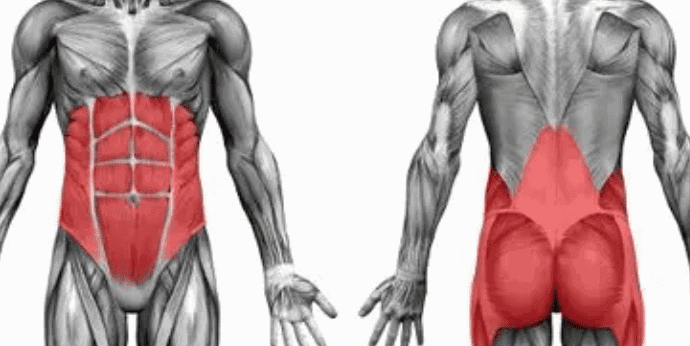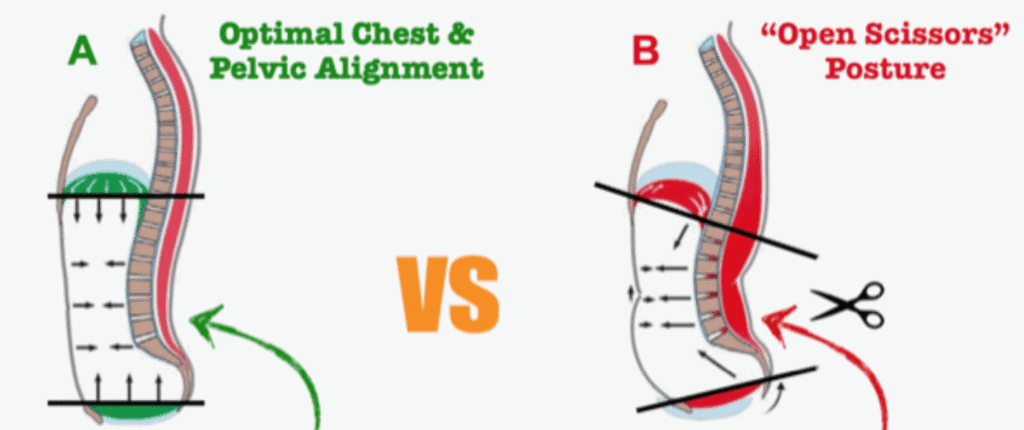The core is quite aptly named as it is the core of the whole body. We generate power from our cores to create momentum through the shoulders, hips, arms and legs. A systematic review of the Effect of Core Training on Skill Performance Among Athletes (1) suggests “that core training should be considered integrated into athletes’ daily training routines…[because] strong core muscles function as hubs in the biological motor chain, which create a fulcrum for the four limbs’ strength and establish a channel for the cohesion, transmission, and integration of the upper and lower limbs.”
In other words, every single biomechanical system depends on the core’s integrity to function properly. A stable core is the foundation to healthy movement patterns that can prevent pain conditions in the back, hips, shoulders, elbows, knees, and ankles.
The Core Anatomy

The core is more than just the abdominal muscles. The core also includes the oblique muscles, back muscles and gluteal muscles (Figure 1). These muscles are all a part of the mechanism that provides pelvic stability. When these muscles work together, they provide a stable core and optimal pelvic alignment, e.g. the ribs stack on top of the pelvis instead of creating an “open scissor posture” where the ribs flare up relative to the pelvis (Figure 2).

The Exercise: Glute Bridge with Core Activation
This exercise is designed to work on the coordination of the transverse abdominus muscles with the gluteal muscles. When 10 to 20 repetitions of this exercise is completed, it achieves what is called “time under tension.” Time under tension is how core muscles are strengthened because they have to be strong endurance muscles, withstanding the load of repetitive movements like running/walking or time-demanding activities like standing for long periods. Think of a plank exercise, that type of exercise is usually done for a period of time since the accumulation of time challenges the edurance of the core muscles to make them stronger. The exercise in this article has the same effect.
To perform a glute budge with abdominal activation:
- Begin with an exercise band around the knees
- Press out into the band so your knees are tracking in line with your feet, and maintain this pressure for the entire exercise.
- Gently activate the core muscles by flattening your spine into the floor and maintaining the position of your ribs stacked over your pelvis.
- Squeeze the gluteal muscles in this position.
- Press up into a bridge with your knees pressing into the band and maintaining an active core.
- Lower down to the starting position while also maintaining the knee and core position.
- Repeat 10 repetitons or repeat for one minute, slowly increasing how long you perform the exercise over time.
Note: This is not to serve as medical advice. Do not begin a new exercise regimen without consulting your physician.
The Takeaway
The core is a group of muscles that stabilize your spine and pelvis as well as serve as the source of power-generation for the rest of your body. Training a healthy core can help prevent pain and injury in the spine, hips, knees, and shoulders (to name a few). A healthy core includes strength in the abdominal, oblique, back, and gluteal muscles. Core-targeted exercises – like the glute bridge with abdominal bracing – are ways to build the core endurance necessary for the activities of daily life or the demands of any athletic endeavor. Everything begins with the core.
If you or someone you know is suffering from any pain condition from a poorly conditioned core, our physicians in Tampa, St. Petersburg, Orlando, or Sarasota are a great place to start in seeking to understand the root cause and possible non-surgical solutions.
References:
- https://www.ncbi.nlm.nih.gov/pmc/articles/PMC9227831/









